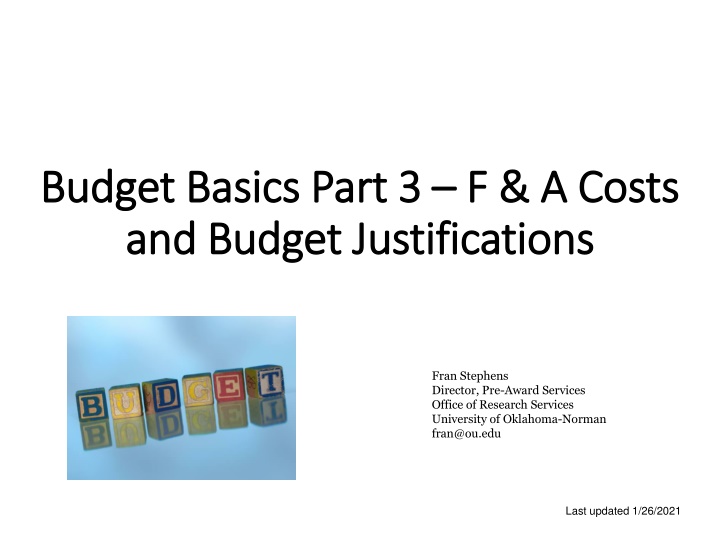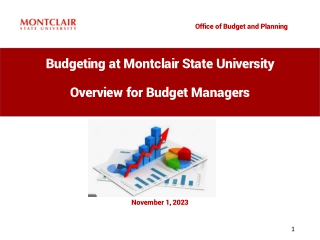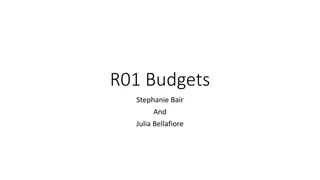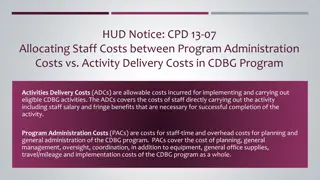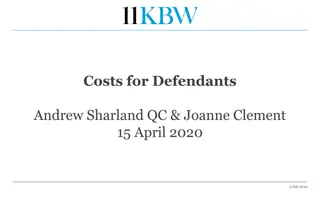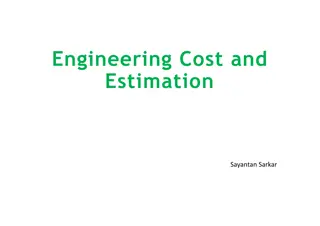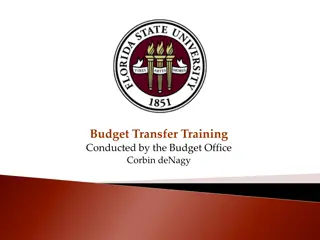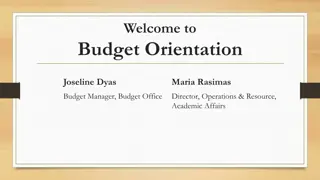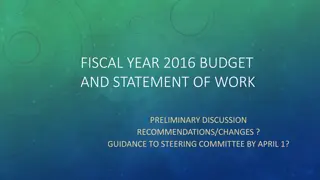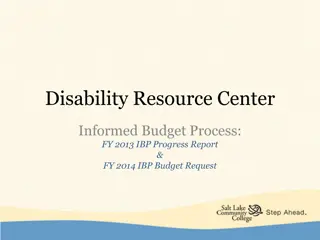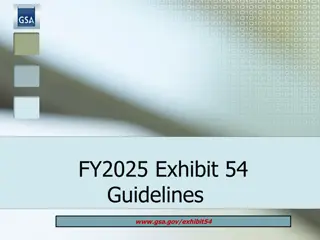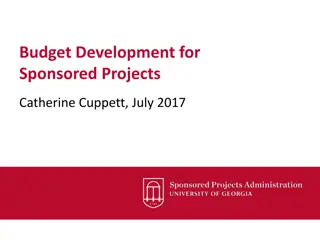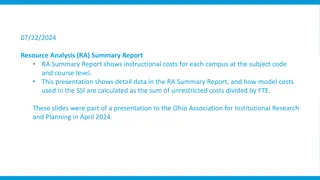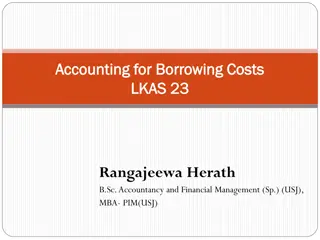F&A Costs and Budget Justifications Explained
In-depth discussion on Facilities & Administrative Costs (F&A) including rates, types, and application bases. Learn about Negotiated Indirect Cost Rate Agreements (NICRA) and creating budget justifications. Understand the importance of pre-award budget documentation for post-award utilization. Explore common objectives, allocation of costs, and key components in budgeting processes.
Download Presentation

Please find below an Image/Link to download the presentation.
The content on the website is provided AS IS for your information and personal use only. It may not be sold, licensed, or shared on other websites without obtaining consent from the author.If you encounter any issues during the download, it is possible that the publisher has removed the file from their server.
You are allowed to download the files provided on this website for personal or commercial use, subject to the condition that they are used lawfully. All files are the property of their respective owners.
The content on the website is provided AS IS for your information and personal use only. It may not be sold, licensed, or shared on other websites without obtaining consent from the author.
E N D
Presentation Transcript
Budget Basics Part 3 Budget Basics Part 3 F & A Costs and Budget Justifications and Budget Justifications F & A Costs Fran Stephens Director, Pre-Award Services Office of Research Services University of Oklahoma-Norman fran@ou.edu Last updated 1/26/2021
Budget Basics Part 3 Budget Basics Part 3 Objectives Objectives Understand the use of a Negotiated Indirect Cost Rate Agreement (NICRA). Create budget justifications to support your proposal s budget components Identify the importance of pre-award budget documentation to assist with post-award utilization.
Budget Basics Part 3 Budget Basics Part 3 Overview Facilities & Administrative Costs Cost Share (minor info) Budget Justifications Revisions, Modifications, Supplements Pre-Award Documentation/Processes Assisting in Post Award Budget Utilization
Facilities & Administrative (F&A) What is F&A? Costs incurred for common or joint objectives which cannot be allocated to a specific direct cost activity Facilities (lab and office space) Salaries of administrative, clerical staff, custodian, HR staff, etc. Libraries and other common buildings Building maintenance, utilities Also called Indirect Costs (IDC) and Overhead (for profit) Usually established by negotiation with Cognizant Agency May include fringe benefits and F&A rate F&A/Indirect Cost (IDC) rate Number(s) used to calculate recovery of some indirect costs.
Facilities & Administrative (F&A) The type of rate you have is usually in your Negotiated Indirect Cost Rate Agreement (NICRA) Cognizant authority is who negotiates rate agreement on behalf of federal government. (DHHS and ONR are primary but any federal agency can approve a rate.) There are four different types of rates that can be in a rate proposal (if a sponsor asks, it is on the rate agreement) Provisional Final Pre-determined Fixed (Fixed Carry-forward)
Facilities & Administrative (F&A) F&A is applied to a base or distribution base There are different kinds of bases that can be used Modified Total Direct Costs (MTDC) Total Direct Salaries and Wages, excluding Fringe Benefits (S&W) Total Direct Salaries and Wages, including Fringe Benefits (SWF) Modified Total Direct Costs (MTDC) excludes capital expenditures and distorting items such as passthrough funds, major Subcontractors, etc. For nonprofit entities, MTDC includes the first $25,000 of sub grants/Subcontracts, while the remaining portion of Subgrants/Subcontracts over $25,000 is excluded.
Facilities & Administrative (F&A) Activity Type or Activity Code is also important (and many people refer to the rate associated with a code as the IDC rate). The major function and/or location of the proposed sponsored work can affect the applicable F&A rate(s). Common ones are: Organized Research Instruction Other Sponsored Activity Off campus Some institutions apply more than one rate to components of a budget based on the Activity Codes that could be applied; some institutions only use one code that covers the majority of the work to be done (OU is the latter) It is possible to have an activity code determining the rate and to have an activity code that doesn t determine the rate (for example the project is deemed to be Other Sponsored Activity but the rate is restricted by the sponsor to 8%)
Facilities & Administrative (F&A) Companies may have unusual IDC agreements and may call IDC overhead or profit . Rate may be proprietary. May be over 80-100%. When dealing with a foreign entity check sponsor guidelines; it is not unusual to find non-domestic funds limited. Some sponsors allow fees on top of direct and indirect charges (example-DoED sometimes has an evaluator fee at the end of their budget form). This is not IDC/F&A.
Facilities & Administrative (F&A) New wrinkle shared idc (E.g. USDA at 30%) total limit for whole proposal including subcontracts Even division among parties Subcontracts first cut; Prime first cut Offset division ??? Sponsor can limit idc recovery OU usually accepts the limitation if it is officially established in guidance, solicitation, website, by board Sponsor limitation normally follows or is tied back to the source solicitation/sponsor Sponsor limitation of the rate usually results in an internal cost share commitment being shown for the unrecovered amount; this is usually not reported to the sponsor unless it is part of a cost share package.
Facilities & Administrative (F&A) Uniform Guidance established a Federal de minimus rate of 10% that can be used by anyone without a rate agreement. Other two options if an organization doesn t have a rate agreement is they can request a rate as part of the submission process or they can direct cost charge as much of the project costs as they can. Rate negotiation is an involved process, only the Provost, President, VPRP and their legally appointed designees are allowed to negotiate the NICRA or to approve, negotiate, or set a rate other than the full research rate.
Facilities & Administrative (F&A) Uniform Guidance established a Federal de minimus rate of 10% that can be used by anyone without a rate agreement. Other two options if someone doesn t have a rate agreement is they can request a rate as part of the submission process or they can direct cost charge as much of the project costs as they can. Rate negotiation is an involved process, only the Provost, President, VPRP and their legally appointed designees are allowed to negotiate the NICRA or to approve, negotiate, or set a rate other than the full research rate.
Cost Share Cost Share There are three types of cost sharing Involuntary committed (mandatory) required by the sponsor as a condition of the award Voluntary committed when the institution volunteers and commits to bear a specific portion of the costs of the project (matching funds, percentages of cost, etc.) Voluntary uncommitted-when the PI chooses to spend some unspecified amount of effort or other resources beyond what is being paid for or required by the sponsor If your proposal requires cost share your PDS can provide some info on sources and documentation needed. Sometimes the solicitation will prescribe what is allowed in the cost share package. Do not provide cost share unless you need to, and if possible show it as unquantified. Quantified cost share must be tracked whether the sponsor includes the reporting of it in the award documents or not and it also becomes an audit issue.
Budget Justifications Budget Justifications What is a budget justification? Narrative of the numbers, explaining how the numbers were developed and with more information than what the budget chart/spreadsheet provides. For example: Travel: where to, how long, method of travel, purpose of travel; Supplies: how many, what type, catalog prices; Equipment: quotes or catalog prices May also be referred to as a Cost Proposal DOE has a budget form called a budget justification OU requires a detailed budget justification at proposal submission regardless of sponsor requirement for a budget justification If the sponsor doesn t ask for it try to reduce numbers where you can (numbers and formulas makes it harder to update/change) Tables and charts can be useful Sponsor may want budget justification for one year with explanation of differences on additional years or may want one for each year Sponsor may require a copy of the rate agreement be submitted as part of the budget justification.
Budget Justifications Budget Justifications Sponsor may want both a full budget and a redacted budget with certain information removed. Sponsor may want budget or budget justification depicted in multiple ways (calendar year, fiscal, real year, w or w/o inflation, tasks, period/phase, etc.) Sponsor may ask for the Basis of Estimate (BOE) or Basis of Costs (BOC); this may just be an explanation such as online search, government rates, catalog, based on current appointment, PI prior experience or may include copies of documents or quotes. If you have a subcontract on the proposal it is likely the sponsor will want a full budget and justification in the submission OU requires a detailed budget and justification plus SOW and official letter of intent regardless of what the sponsor wants for submission from a subcontract.
Revisions, Modifications, Supplements Revisions, Modifications, Supplements Revisions to budget are very common prior to award; normally with a reduction. Don t automatically assume cost share; objectives may need to be reduced PI should notify their ORS/OSP office if they receive any notices or questions on a possible revision Take opportunity to update salaries, fringe, tuition, and idc rates Modifications to the award may impact the budget (overall amount, budget structure, period/task/expenditure timing) May not involve rate changes beyond fringe (if that is even considered) Shifting of funds in budget categories may have thresholds for approval (or not) and may or may not involve modifications.
Revisions, Modifications, Supplements Revisions, Modifications, Supplements Supplements are usually tied to the original awards rates and can be for a variety of purposes Addition of personnel to achieve objectives Change in scope of work/objectives Research Experience for Undergraduates (REU) Conference/Meeting travel Special assistance/needs Diversity opportunities Rate changes are usually not addressed when they occur unless some action is taking place (and sometimes not then either). Usually, salary and fringe are billed at their current and actual rate which could result in budget modifications (shifting funds, changes in effort)
Pre-Award Documents vs Post Award Use Pre-award processes Compliance items cost principles, guidelines/solicitation Documentation of the budget, any budget forms, cost share, subcontracts Approval/coordination with PI, CoPI, Dept/Chair, other parties Basis of Estimate or Basis of Cost Quotes (company, catalog, on-line sources) Equipment; Materials & Supplies PI experience Currency Travel federal policies (Fly America, government per diem rates, IRS mileage rates) local policies (mileage rates) approvals needed (internal and external and may be before travel arrangements are made) details including quotes may be needed Participant support (legitimate participant support, not study participants) detailed information to include number of participants; costs only the participants not employees of the hosting organization or project; not speakers or presenters. Gift cards and incentive payments know policies.
Pre-Award Documents vs Post Award Use Understand parameters of award budget before you accept the award Spending before award Permissions required for travel (especially foreign) Shifting funds (some have %ok and some all shifts must be approved) Special limitations (like Participant Support) Carry forward being allowed or not Disposition of equipment and unused supplies Unused funds
Other Budget Considerations Other Budget Considerations Timing of expenditures (impact on budget development/use and burn rate) Consider timing and delays for hiring, equipment purchases Don t assume NCE will be approved Example ONR at FDP last year announced 2 and Done; this year said 3 and done Submit expenses in timely manner (especially subcontract) Don t wait to last minute to bring up issues with PO and Contracts (go through your organizational sponsored projects office) No $$$ last minute purchases What impact do the sponsor s reporting requirements related to the budget have on the budget composition and un-intended consequences. Collaborative submissions (may have split budgets) National Lab funding while included in your budget will usually be split off and sent directly to them by the sponsor; this is usually noted in the budget justification.
Other Budget Considerations Other Budget Considerations Primary submitter s budget with a subcontract May have just a line entry for the subcontract amount in the budget and a short description in the budget justification May have an entire subcontract budget loaded and a full subcontract budget justification Usually have both (inclusion in prime budget info and separate package) Subcontract If you are a subcontract or have a subcontract, know that a subcontract package (including budget and justification) may be needed regardless of whether the sponsor requires it for submission or not. Being a subcontract or having a subcontract can impact the timing of your proposal routing and submission. Special Budget Forms Do you need different internal and external budgets PMC 123 (DOE budget Justification)
Getting Help Getting Help Read solicitation and look for general guidelines FAQs may also be posted Talk with your Proposal Development Specialist (PDS) Network talk with colleagues, department chair/dean/director Talk to your Program Officer Sponsor list serves and websites (especially division level)
